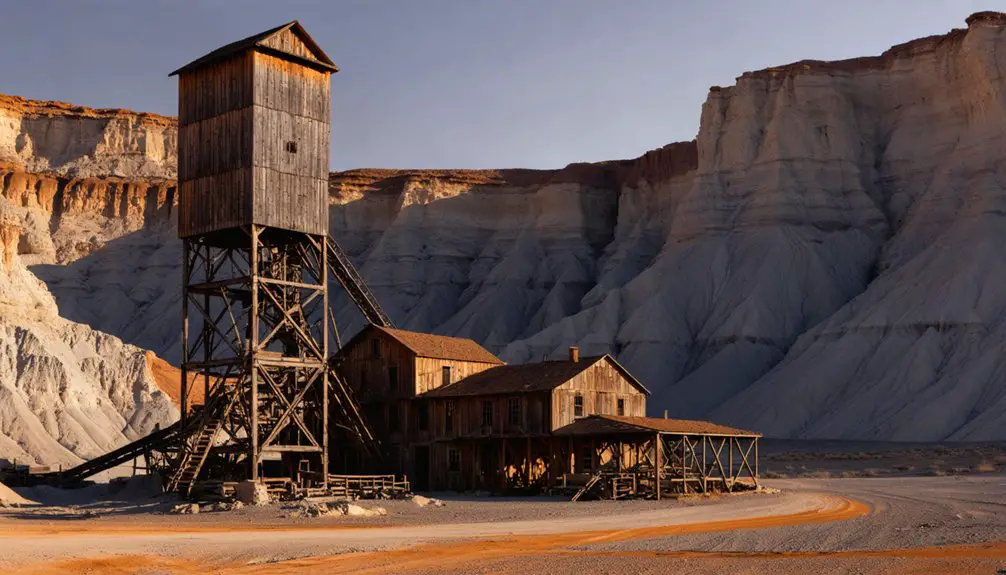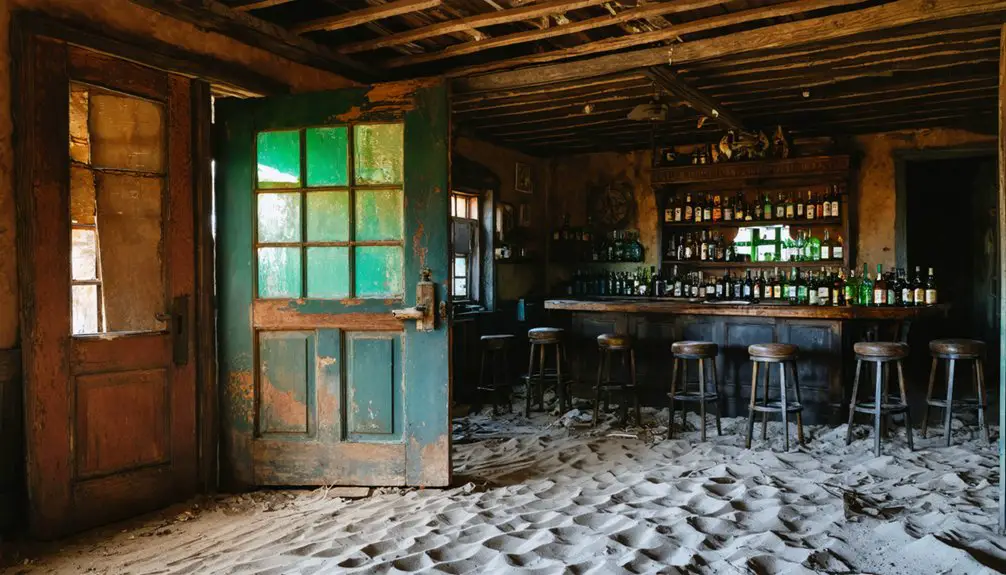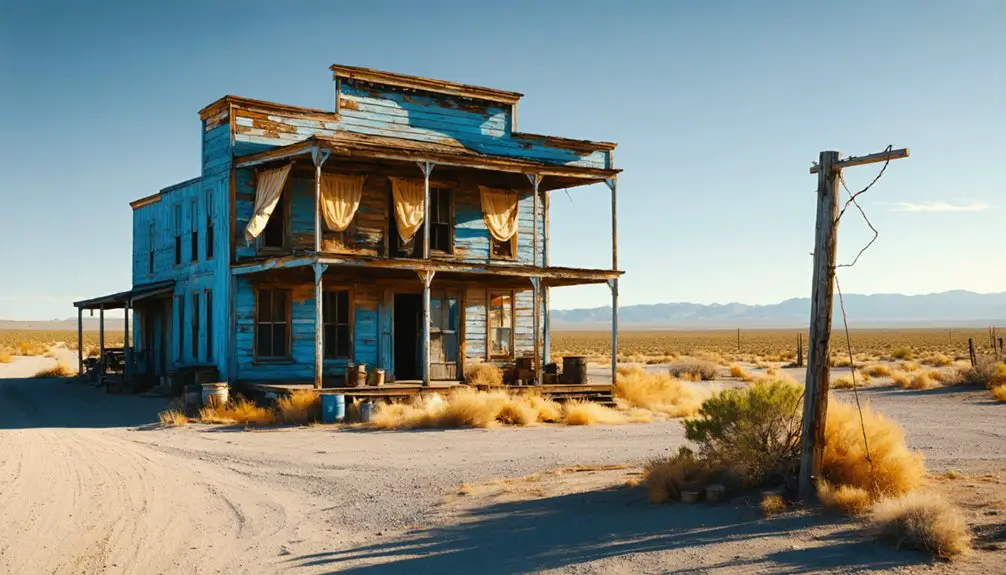You’ll find Wonder, Nevada’s remains at 5,853 feet on Wonder Mountain, where silver and gold discoveries in 1906 sparked a mining rush. The town flourished with advanced infrastructure, including the world’s longest electric transmission line and a sophisticated 200-ton cyanide mill. By 1919, Wonder had produced over $6 million in precious metals before its decline. Today, mill foundations, ground depressions, and dangerous mine shafts mark this remote ghost town‘s remarkable past.
Key Takeaways
- Wonder, Nevada was a prosperous silver and gold mining boomtown established in 1906, located 39 miles east of Fallon.
- The town’s mining operations generated over $6 million in revenue before declining in 1919 when mineral deposits were exhausted.
- At its peak, Wonder featured advanced infrastructure including a 200-ton cyanide mill and the world’s longest electric transmission line.
- The town was completely abandoned by 1920, with its infrastructure systematically dismantled and post office closure marking its end.
- Today, visitors can explore mill foundations, ground depressions, and geological features, though numerous unmarked mine shafts pose safety risks.
The Birth of a Mining Boomtown
When Thomas L. Stroud discovered silver and gold deposits on the Jackpot claims in early 1906, you’d have witnessed the birth of one of Nevada’s most dynamic mining communities.
The subsequent find of the Nevada Wonder mine by Murray Scott and William Mays set off a chain reaction in the prospecting culture of the region. Within weeks, over 1,000 claims sprouted across the landscape as fortune seekers poured in from nearby Fairview. Miners flocked to the area with the promise of earning $5 per day for their labor.
The community dynamics shifted rapidly as the Wonder Mining District took shape later that year. You’ll find it remarkable how quickly essential services emerged – telephone lines were running by November 1906, and the town’s infrastructure expanded to support the growing population. A critical development came with the construction of a 200-ton cyanide mill in 1913.
The establishment of the Nevada Wonder Mining Company in September 1906 cemented Wonder’s position as a serious mining operation.
Life in Early Wonder
You’d find daily life challenging in early Wonder, where residents contended with the harsh realities of living at 7,000 feet elevation on Wonder Mountain.
Despite having access to water from Bench Creek, you’d need to navigate the difficulties of extreme temperatures, dust storms, and the constant rumble of mining operations. The town’s first newspaper, the Wonder Mining News, kept residents informed of local developments.
You’d share the mountainside with thousands of other fortune seekers living in a mix of canvas tents and hastily constructed wooden structures, paying premium prices for even basic shelter as property values soared to $8,000 per business lot. The bustling town quickly established itself with five separate saloons to serve the growing population.
Daily Frontier Hardships
Life in early Wonder, Nevada demanded extraordinary resilience from its inhabitants, who faced a barrage of daily challenges in this harsh mining frontier.
You’d find community resilience tested daily through labor struggles, as miners endured dangerous conditions in unstable tunnels and toxic chemical exposure. Living conditions were equally harsh, with limited access to water, basic amenities, and proper housing. The presence of the St. Francis Hotel briefly offered a glimpse of luxury amid the rugged frontier conditions. A devastating smallpox outbreak in 1915 further strained the community’s resources and tested their resolve.
- Strenuous physical labor in poorly ventilated shafts led to respiratory problems
- Limited water access required a 10-mile pipeline from Horse Creek
- No electricity until 1911 meant primitive lighting and heating
- Food and supplies had to be transported from distant towns
- Medical care was scarce, leaving residents to rely on informal treatments
The boom-bust cycles of mining operations created constant economic uncertainty, while the arid climate and limited resources made everyday survival a continuous challenge.
Living Above Ground Level
Despite its remote location, Wonder’s above-ground infrastructure expanded rapidly after the 1906 mineral discoveries, transforming into a bustling frontier town within months. You’d find five hotels, two banks, six general stores, and various businesses supporting a population of 1,200 residents, demonstrating remarkable community resilience.
The town’s survival strategies included cutting-edge utilities for its time. You could access telephone service by late 1906, and by 1911, Wonder boasted one of the world’s longest electric transmission lines from Bishop, California. The town’s commitment to innovation was further demonstrated by its 200-ton cyanide mill. Like many ghost towns in Nevada, Wonder preserved fascinating remnants of its mining heritage.
A sophisticated 10-mile water pipeline from Horse Creek, complete with sediment cleaning systems, supplied the town’s needs. Despite high living costs and harsh conditions, the community thrived with schools, social venues, and essential services until mining operations ceased in 1919.
Mining Operations and Development
You’ll find Wonder’s first mining rush began in April 1906 when T.J. Stroud discovered silver-gold deposits on the Jackpot claims, quickly drawing over 1,000 claim filings within weeks.
The Nevada Wonder Mining Company, formed in September 1906, emerged as the district’s dominant operator despite a brief pause during the 1907 financial panic. The company’s success led to the construction of a 100-ton mill in 1911.
Early Mining Rush
After T.J. Stroud discovered rich silver-gold ore on the Jackpot claims in early 1906, you’d have witnessed one of Nevada’s most explosive mining rushes.
Within weeks of Murray Scott and William Mays’ additional discoveries, over 1,000 prospectors, mainly from Fairview, staked their claims despite challenging terrain and prospecting challenges.
- Advanced mining techniques weren’t necessary initially due to rich quartz veins
- Prospectors faced extreme competition with thousands flooding the area
- Multiple mining camps sprouted nearby, including Hercules and Kingston
- Claims sold for unprecedented prices in the rush
- Development occurred at breakneck speed with tents giving way to permanent structures
Nevada Wonder Mill Operations
While the initial rush brought thousands of prospectors to Wonder, the Nevada Wonder Mill would become the district’s cornerstone of industrial mining operations. Built in 1913, the 200-ton cyanide mill featured the most advanced electrical machinery of its time, processing 75 tons of ore daily at peak production.
You’ll find it remarkable that the mill received its power from Bishop, California, through what was then the world’s longest electrical transmission line.
The operation employed 150 workers and supported a stable population of 500 residents for eight years. The town’s two active banks served the thriving mining community during this period. By 1919, the mill had helped generate over six million dollars in revenue and paid dividends exceeding $1.5 million.
The ore processing facility thrived until December 1919, when operations ceased and workers began dismantling its mill machinery.
Engineering Marvels and Infrastructure
Despite its remote location, Wonder boasted some of Nevada’s most impressive engineering achievements of the early 1900s.
You’ll find remarkable water engineering feats, including a revolutionary waterline that delivered 185,000 gallons daily from Horse Creek, positioned 2,135 feet above the valley floor. This infrastructure legacy continues to influence modern waterline construction techniques.
- World’s longest electric transmission line at the time, stretching from Bishop, California
- Advanced 200-ton cyanide mill that processed ore until 1919
- Sophisticated water delivery system with a 100,000-gallon overflow tank
- Early telephone service establishment by 1906, connecting the remote district
- Complex transportation network utilizing 1,000 horses for continuous supply delivery
The town’s rapid development showcased pioneering infrastructure that supported mining operations, sustained a population of 1,200, and demonstrated remarkable engineering innovation in harsh terrain.
Geological Treasures

Beneath Wonder’s surface lies a complex network of low-sulfidation epithermal deposits, characterized by quartz and adularia-rich veins embedded in brecciated volcanic rock.
These remarkable geological formations contain valuable ore minerals, including acanthite and various silver halides, alongside significant gold deposits.
Rich mineral deposits showcase remarkable ore formations, with acanthite and silver halides complementing abundant gold resources throughout the system.
You’ll find evidence of extensive hydrothermal alteration throughout the mineral deposits, where hot, silica-rich fluids transformed the surrounding rock.
The deposit’s formation in an oxygen-rich environment led to deep oxidation and secondary enrichment, concentrating precious metals near the surface.
While these geological treasures once made Wonder a mining hotspot, today they’re partially exposed through open pits and old shafts.
If you’re exploring the site, watch for unstable ground caused by brecciated rock and collapsed workings in this historically rich mining landscape.
The Town’s Golden Years
After Thomas J. Stroud discovered rich silver-gold ore in 1906, Wonder exploded with mining culture and economic impact. You’d have witnessed over 1,000 mining claims staked within weeks, as the town rapidly grew to include banks, stores, and numerous saloons.
By 1913, the Nevada Wonder Mining Company had established a 200-ton cyanide mill, employing 200 men who earned up to $4.50 daily.
- Property values skyrocketed with lots selling for $8,000 in the first year
- Two newspapers and a post office emerged by August 1906
- The town boasted the world’s longest power transmission line from Bishop, California
- Advanced infrastructure included telephone service and a sophisticated water pipeline
- The mining operations generated approximately $1.55 million before closing in 1919
Decline and Abandonment

While Wonder’s mineral riches had fueled its meteoric rise, by 1919 the town’s once-productive veins of silver and gold lay largely exhausted. The Nevada Wonder Mining Company’s closure that December triggered a devastating economic downturn, leading to a rapid community exodus.
You’d have witnessed the systematic dismantling of the town’s infrastructure – the post office closed in 1920, followed by the removal of the massive cyanide mill and the world’s longest electric transmission line by 1924.
Buildings were either relocated to other mining camps or left to decay. Despite sporadic mining attempts into the 1930s, Wonder never recovered its former glory.
The final blow came in 1942 when Executive Order L-208 halted all remaining operations. Today, you’ll find only foundations, mill remnants, and hazardous mine shafts marking Wonder’s brief existence.
Exploring Wonder Today
Today, you’ll find Wonder’s ghostly remains nestled in Churchill County, Nevada, approximately 39 miles east of Fallon. Access to this historical preservation site requires an off-road vehicle via a dirt road from US 50 East, where you’ll discover the remnants of a large mill perched on the eastern hillside at 5,853 feet elevation.
Hidden in Nevada’s Churchill County, Wonder’s ghost town whispers tales of its mining past from atop a remote eastern hillside.
Ghost town exploration enthusiasts can examine:
- Mill foundations and scattered wooden structures that hint at the town’s bustling past
- Ground depressions marking former residences and businesses from the 1906-1919 boom
- Rich geological features including quartz, adularia, and brecciated volcanic rock
- Mining infrastructure remnants that showcase early 20th-century technology
- Historical evidence of a once-thriving community that produced the Wonder Mining News
Exercise caution while exploring – numerous unmarked mine shafts pose significant safety risks.
Frequently Asked Questions
Were Any Famous Outlaws or Gunfights Associated With Wonder’s Mining Days?
You won’t find documented outlaw legends or gunfight tales specifically tied to Wonder’s mining period of 1906-1919, despite Nevada’s broader reputation for Wild West lawlessness during earlier decades.
What Was the Total Value of Gold and Silver Extracted?
Like precious metals shimmering in desert light, you’ll find Wonder’s documented gold production reached $1,549,002 through advanced mining techniques, though that’s just from the main company’s operations through 1919.
Did Any Major Fires or Natural Disasters Affect Wonder?
You won’t find records of major fire incidents or natural disaster impacts in Wonder’s history, except for a challenging winter in 1912-1913 that froze and damaged the water pipeline.
What Happened to Wonder’s Residents After the Town Declined?
Like scattered seeds seeking fertile ground, you’d find Wonder’s former residents dispersed to nearby towns after 1919, driven by economic impact and population migration following mine closures.
Are There Any Documented Paranormal Activities or Ghost Stories From Wonder?
You won’t find specific documented ghost sightings from Wonder itself, though local legend suggests haunted locations around the mine shafts and ruins share paranormal traits with neighboring Nevada ghost towns.
References
- https://www.ghosttowns.com/states/nv/wonder.html
- https://forgottennevada.org/sites/wonder.html
- https://www.nvexpeditions.com/churchill/wonder.php
- https://en.wikipedia.org/wiki/Wonder
- https://www.greatbasinbicycles.com/new-blog/2020/10/5/wonder-nevada-a-gold-mining-ghost-town-55-miles-east-of-fallon
- https://shpo.nv.gov/nevadas-historical-markers/historical-markers/wonder
- https://forgottennevada.org/sites/hercules.html
- https://www.nevadaappeal.com/news/2017/sep/28/richard-moreno-not-quite-a-wonder-of-the-ages/
- https://nvtami.com/2021/06/02/hercules-vulture-jack-pot-mines-nevada/
- https://nvtami.com/2025/06/25/lincoln-county-ghost-town-trip/



